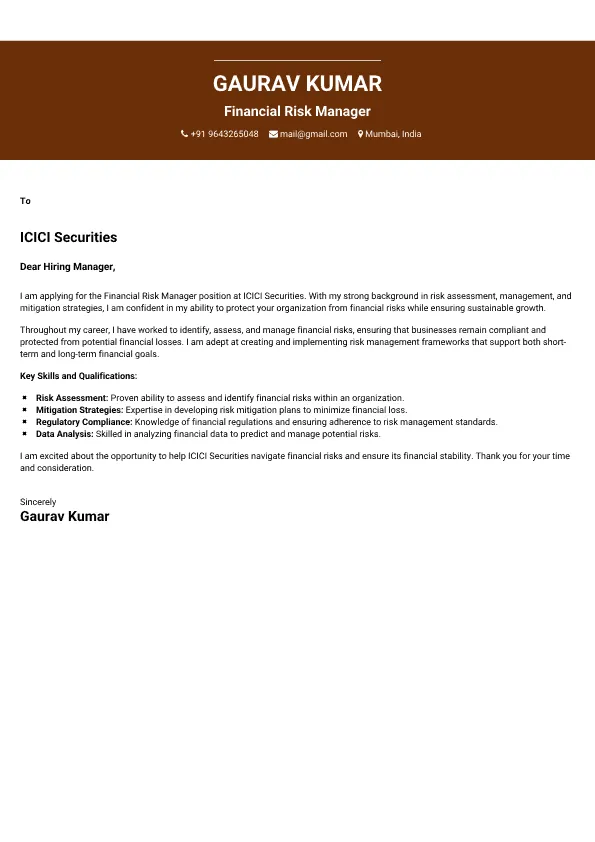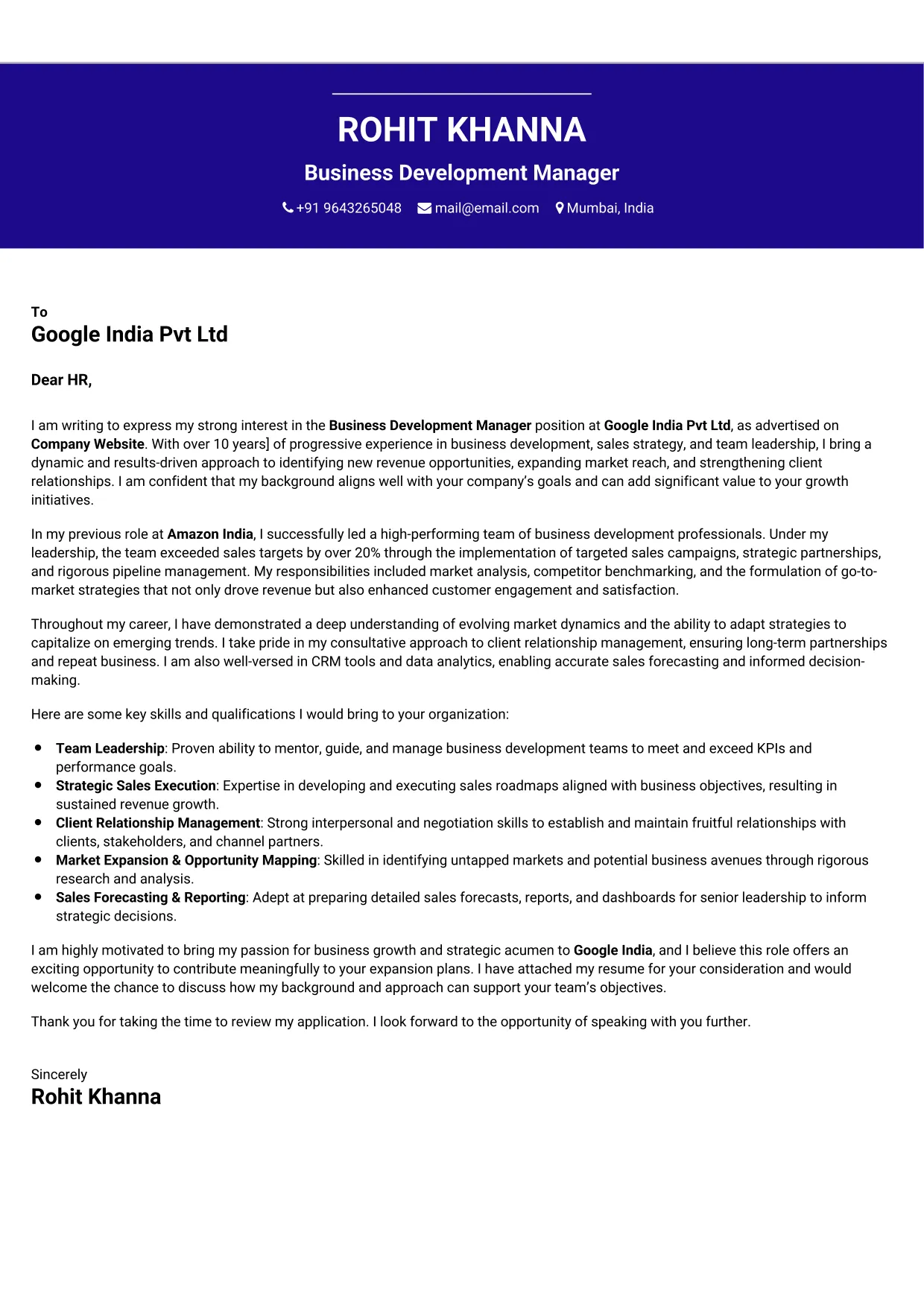Financial Risk Manager
Welcome to our Financial Risk Manager cover letter sample page! This professionally designed template is crafted to highlight your expertise in identifying, assessing, and mitigating financial risks across various domains (e.g., credit, market, operational, liquidity). Whether you’re working in banking, investment management, or corporate finance, this sample emphasizes key skills like risk modeling, quantitative analysis, regulatory compliance (Basel, FRTB, Solvency II), policy development, and strategic risk advisory. Tailored to meet 2025 employer expectations, this guide will help you create a compelling cover letter that stands out in the competitive financial services industry and secures your next pivotal leadership role.

Superbresume.com empowers Financial Risk Managers to craft cover letters that showcase their ability to safeguard assets and ensure stability. Our platform provides customizable templates tailored for high-stakes risk roles, emphasizing expertise in quantitative risk modeling, regulatory frameworks, and strategic mitigation. With ATS-optimized formats, expert-written content suggestions, and real-time feedback, we ensure your cover letter aligns with complex risk mandates. Highlight achievements like reducing potential losses, implementing robust risk frameworks, ensuring audit readiness, or providing critical insights that enhanced capital efficiency with confidence. Superbresume.com helps you create a polished, results-driven cover letter that grabs hiring managers’ attention and lands interviews at leading financial institutions.
How to Write a Cover Letter for a Financial Risk Manager
Craft a Targeted Opening: Write a 2-3 sentence introduction highlighting your expertise in financial risk management and your ability to develop and implement robust risk frameworks that protect capital and ensure compliance.
Address the Hiring Manager: Use the hiring manager’s name (e.g., “Dear Ms. Gupta”) to personalize the letter and show attention to detail.
Highlight Relevant Experience: Focus on your experience with credit risk assessment, market risk analysis (VaR, stress testing), operational risk management, liquidity risk, regulatory reporting, or developing risk policies and procedures.
Quantify Achievements: Use metrics prominently, e.g., “Developed a new credit risk model that reduced potential loan defaults by 10%,” or “Implemented a market risk framework resulting in a 5% reduction in capital allocation for trading books.”
Incorporate Keywords: Include terms like “risk modeling,” “quantitative analysis,” “regulatory compliance (Basel III/IV, FRTB),” “VaR,” “stress testing,” “operational risk,” “credit risk,” “Python/R for risk analytics,” or “risk appetite framework” from the job description to pass ATS filters.
Showcase Software & Quantitative Proficiency: Mention mastery of statistical software (R, Python, SAS), financial risk management systems, and advanced Excel for modeling.
Emphasize Strategic Impact: Highlight how your risk management strategies directly supported business objectives, improved decision-making, or enhanced capital efficiency.
Demonstrate Communication & Stakeholder Management: Include examples of presenting complex risk assessments and recommendations to senior management, regulators, or board members.
Keep It Concise: Limit the cover letter to one page, focusing on your most impactful contributions to risk mitigation and financial stability.
Close with Enthusiasm: End with a strong call to action, e.g., “I am eager to contribute my expertise in managing financial risks to enhance [Company Name]'s resilience and support its strategic growth initiatives.”
AI/Machine Learning in Risk Modeling: Employers highly value experience with or understanding of how AI and machine learning are being used for credit scoring, fraud detection, or market risk prediction.
Climate Risk & ESG Integration: Showcase expertise in assessing and managing climate-related financial risks and integrating Environmental, Social, and Governance (ESG) factors into risk frameworks.
Cybersecurity Risk Management (Financial Sector): Emphasize understanding of cybersecurity threats to financial systems and experience in developing controls to mitigate them.
Regulatory Technology (RegTech) Adoption: Highlight familiarity with RegTech solutions that automate compliance, reporting, and risk monitoring.
Data Governance for Risk: Demonstrate strong understanding of data quality, data lineage, and data governance best practices for accurate risk reporting.
Liquidity & Capital Management under Stress: Focus on experience with advanced liquidity stress testing and capital planning in volatile markets.
Behavioral Risk Management: Note understanding of how human behavior and organizational culture contribute to operational risk and how to mitigate it.
Cross-Border & Geopolitical Risk: If applicable, mention experience in assessing and managing risks related to international markets, trade policies, or geopolitical events.
Choose Superbresume.com to craft a Financial Risk Manager cover letter that truly reflects your strategic insight. Our platform offers tailored templates optimized for ATS, ensuring your expertise in quantitative modeling, regulatory compliance, and risk mitigation shines. With expert guidance, pre-written content, and real-time feedback, we help you highlight achievements like reducing potential losses, strengthening risk frameworks, or ensuring audit readiness. Whether you’re managing credit risk in banking or operational risk in investment, our tools make it easy to create a polished, results-focused cover letter. Trust Superbresume.com to showcase your analytical rigor and secure interviews at leading financial institutions.
20 Key Skills for a Financial Risk Manager Cover Letter
| Quantitative Risk Modeling | Credit Risk Management |
| Market Risk Analysis (VaR, Stress Testing) | Operational Risk Management |
| Regulatory Compliance (Basel, FRTB) | Liquidity Risk Management |
| Python / R (Risk Analytics) | Data Analysis & Visualization |
| Risk Policy Development | Internal Controls |
| Capital Management | Enterprise Risk Management (ERM) |
| Scenario Analysis | Financial Instruments Knowledge |
| Problem-Solving (Complex) | Communication (Strategic) |
| Attention to Detail | Critical Thinking |
| Stakeholder Management | Statistical Analysis |
10 Do’s for a Financial Risk Manager Cover Letter
Lead with Quantifiable Impact
Highlight Regulatory Expertise
Showcase Quantitative Skills
Discuss Diverse Risk Types
Include Policy & Framework Development
Optimize for ATS
Keep It Professional & Authoritative
Mention Strategic Alignment
Proofread Meticulously
10 Don’ts for a Financial Risk Manager Cover Letter
Don’t Be Vague About Risk Outcomes
Don’t Exceed One Page
Don’t Skip Regulatory Knowledge
Don’t Use Complex Formats
Don’t Omit Quantitative Skills
Don’t Focus Only on Technical Details
Don’t Ignore Strategic Impact
Don’t Include Irrelevant Experience
Don’t Forget to Research
5 FAQs for a Financial Risk Manager Cover Letter
Prioritize quantitative risk modeling, regulatory compliance (Basel, FRTB), specific risk types (credit, market, operational), data analysis, and strategic communication.
Use standard formatting, avoid graphics, and include keywords like “risk framework,” “VaR,” “stress testing,” “regulatory capital,” and specific risk software from the job description.
You can mention the types of models (e.g., PD, LGD, VaR models) or their purpose (e.g., for credit underwriting, market volatility), but avoid overly technical details that might be proprietary.
Describe instances where your risk assessments or recommendations directly led to changes in strategy, policy adjustments, or improved risk posture by senior management.
Use a professional, analytical, precise, and authoritative tone, conveying your expertise and commitment to safeguarding financial stability.
Get 5x more interviews with our crafted Resumes. We make Cover Letter that land jobs.

Free Customized Cover Letter + Expert Resume Advice
Receive a professionally tailored cover letter absolutely free with every resume order—plus expert guidance to make your resume stand out.
